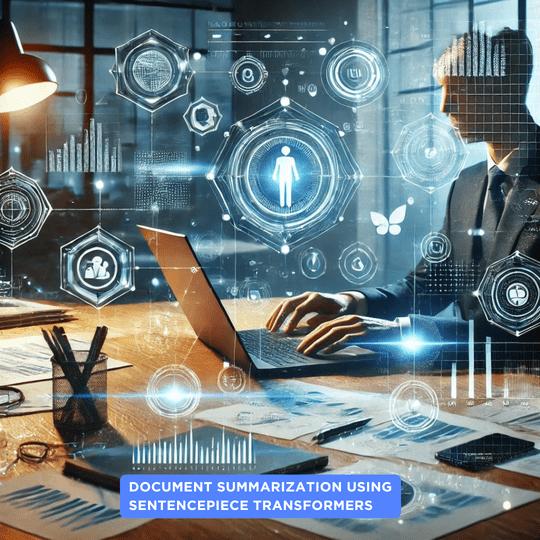Document Summarization Using Sentencepiece Transformers - Best AI Project

Introduction to Document Summarization
In today's fast-paced world, we're constantly bombarded with information. Reading long documents or articles to extract the key points can be time-consuming. Document summarization using AI is a revolutionary technique that allows us to condense lengthy content into shorter, more digestible pieces, saving time and enhancing understanding.
"Document Summarization Using Sentencepiece Transformers - AI Project", introduces a new method to automatically summarize texts using AI models. In this article, we'll walk you through the steps involved in building an AI summarizer using Sentencepiece Transformers, a powerful tool for natural language processing (NLP).
What are Sentencepiece Transformers?
Sentencepiece Transformers are a type of pre-processing tokenization model that converts text into sequences of subwords. They help break down words into smaller parts or subword units, improving the model's ability to understand languages with complex vocabularies. This technique enhances the performance of AI models in text summarization, translation, and language understanding tasks.
Sentencepiece works by learning the most common word fragments and encoding these fragments into numbers. These numbers are then fed into a Transformer model, which learns to summarize the input text accurately.
Benefits of Using Sentencepiece Transformers for Summarization
Using Sentencepiece Transformers for document summarization offers several advantages:
- Efficiency: By breaking words into subword units, the model can process text more efficiently and accurately.
- Handling Unknown Words: Sentencepiece handles out-of-vocabulary words by breaking them into known subword units, improving the model's understanding.
- Multilingual Capabilities: Sentencepiece is effective for summarization in multiple languages, making it a versatile tool for global users.
- Improved Precision: Models built with Sentencepiece are generally more precise in capturing the essence of the document while reducing redundancy.
How Document Summarization Works in AI
Document summarization in AI is the process of shortening a long document while preserving its key information. The two main types of summarization are:
- Extractive Summarization: Involves selecting important sentences from the document and piecing them together to form a summary.
- Abstractive Summarization: This involves generating entirely new sentences that convey the meaning of the original text. Abstractive summarization is more challenging but can produce more human-like summaries.
Sentencepiece Transformers are typically used in abstractive summarization models. They process the input text, transform it into subwords, and generate a summary that maintains the core ideas of the document in fewer words.
Step-by-Step Guide to Implementing Sentencepiece Transformers
Here's a simplified guide to implementing Sentencepiece Transformers for document summarization:
- Data Collection: Start by collecting a dataset of documents you want to summarize.
- Preprocessing: Use Sentencepiece to tokenize your dataset into subwords. This step helps the model to understand the nuances of the text better.
- Model Selection: Choose a pre-trained Transformer model like BART or T5, which are popular for summarization tasks.
- Training: Fine-tune the model using your tokenized dataset. This step teaches the model to generate accurate and concise summaries.
- Evaluation: After training, evaluate the model's performance using metrics like ROUGE (Recall-Oriented Understudy for Gisting Evaluation) scores.
- Deployment: Once satisfied with the model's performance, you can deploy it as a web application, API, or integrate it into your existing system.
Key Features of Document Summarization AI Projects
- Language Support: Sentencepiece Transformers can be applied to a wide range of languages.
- Customizable Summarization: You can adjust the length and detail of the summaries based on user preferences.
- High Accuracy: Sentencepiece ensures that even complex documents are summarized without losing meaning.
- Scalability: Summarization models can be easily scaled to process large volumes of text.
Applications of Document Summarization
The applications of document summarization are vast and diverse. Here are a few examples:
- News Summarization: Automatically generate short news reports from lengthy articles.
- Legal Documents: Summarize contracts, case studies, and other legal paperwork to highlight key points.
- Academic Papers: Researchers can use summarization tools to extract key findings from long scientific papers.
- Business Reports: Companies can summarize financial reports, meeting notes, or market research for easier consumption.
Challenges and Limitations of Summarization Models
While document summarization using Sentencepiece Transformers offers many benefits, there are still some challenges to overcome:
- Quality Control: Abstractive models may sometimes generate grammatically incorrect or irrelevant sentences.
- Computational Costs: Training large models like Transformers requires significant computational resources.
- Domain-Specific Knowledge: Summarization models may struggle with domain-specific jargon or highly technical documents.
- Bias: AI models can sometimes generate biased summaries, depending on the data they are trained on.
Future of AI in Document Summarization
The future of document summarization is promising, with ongoing improvements in AI models like Transformers. As models become more sophisticated, we expect:
- Better Abstractive Summarization: AI will continue to improve in generating human-like summaries.
- Faster Processing: With advancements in computing power, summarization tasks will become faster and more accessible.
- Personalized Summaries: AI could provide custom summaries based on individual reading preferences, such as focusing on specific topics of interest.
Frequently Asked Questions (FAQs)
Q1: What is document summarization in AI?
Document summarization is the process of using AI to condense long documents into shorter summaries while retaining key information.
Q2: How do Sentencepiece Transformers help in summarization?
Sentencepiece Transformers tokenize text into subword units, allowing AI models to process and understand complex languages more effectively for summarization tasks.
Q3: Is document summarization accurate?
Yes, modern AI models like Sentencepiece Transformers can generate highly accurate summaries, though the quality depends on the training data and model fine-tuning.
Q4: Can summarization models handle multiple languages?
Yes, Sentencepiece Transformers support multiple languages, making them effective for multilingual summarization projects.
Q5: What are the challenges of using AI for document summarization?
Some challenges include ensuring grammatical accuracy, handling technical documents, and addressing potential biases in the summarization process.
Conclusion
Document summarization using Sentencepiece Transformers is a powerful AI solution for reducing long documents into concise, meaningful summaries. Whether you're processing legal documents, academic papers, or news articles, this AI project can save you time and effort. By understanding how Sentencepiece tokenizes text and how Transformers generate summaries, you can build a state-of-the-art summarization system for various applications.
The "Document Summarization Using Sentencepiece Transformers - AI Project" combines efficiency, accuracy, and scalability, making it a valuable tool for businesses, researchers, and individuals seeking to streamline information processing in today's data-driven world.

Comments